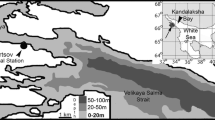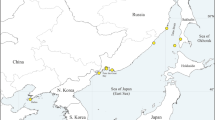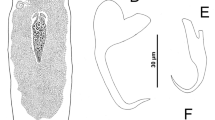Abstract
Eutima sapinhoa n. sp. is a small hydroid, which lives attached by a basal disc to the mantle, foot, gills and labial palps of the bivalve Tivela mactroides (Born, 1778), found on the northern littoral of São Paulo State, Brazil. This bivalve, locally known as “sapinhoá”, is used as food by the coastal inhabitants. The hydroid produces a leptomedusa which belongs to the family Eutimidae. The medusa bud develops as a small knob-like protuberance near the base of the polyp and, after 61/2 days, reaches the free-swimming stage in covered preparation dishes containing about 200-ml filtered sea water at a temperature of 20° to 22°C. After 25 days the medusa is 4 mm high, 4-mm in diameter, and possesses 4 radial tentacles —each about 2 to 3 times as long as the bell diameter, 8 marginal vesicles — 2 in each quadrant, and 28 small marginal swellings — 7 in each quadrant. The peduncle is as long as the height of the bell, 4 single long gonads develop on the subumbrella on each radial canal. The nematocysts are small atrichous isorhizae, with capsules averaging 7 μm in length.
Similar content being viewed by others
Literature Cited
Berrill, N.J.: the polymorphic transformations of Obelia. Q. Jl microsc. Sci. 90, 235–264 (1949)
Brooks, W.K.: On the life history of Eutima and on radial and bilateral symmetry in hydroids. Zool. Anz. 7, 709–711 (1884)
Cerruti, A.: Mytilhydra polimantii n. gen., n. sp. idroide vivente sul mantello dei mitili. Riv. Biol. 32, 1–18 (1941)
Crowell, S.: Eugymnanthea, a commensal hydroid living in pelecypods. Pubbl. Staz. zool. Napoli 30, 162–167 (1957)
— and M. Rusk: Growth of Campanularia colonies. Biol. Bull. mar. biol. Lab., Woods Hole 99, p. 357 (1950)
Kakinuma, Y.: A new commensal hydrozoan Eugymnanthea cirrhifera n. sp. from Hachinohe. Bull. biol. Stn Asamushi 12, 51–57 (1964)
Kramp, P.L.: Synopsis of the Medusae of the world. J. mar. biol. Ass. U.K. 40, 1–469 (1961)
Mattox, N.T. and S. Crowell: A new commensal hydroid of the mantle cavity of an oyster. Biol. Bull. mar. biol. Lab., Woods Hole 101, 162–170 (1951)
Narchi, W.: Comparative study of the functional morphology of Anomalocardia brasiliana (Gmelin, 1791) and Tivela mactroides (Born, 1778) (Bivalvia, Veneridae). Bull. mar. Sci. 22, 643–670 (1972)
Palombi, A.: Eugymnanthea inguilina nuova leptomedusa derivante da un atecato idroide ospite interno di Tapes decussatus. Pubbl. Staz. zool. Napoli 15, 159–168 (1935)
Payne, F.: A study of the fresh-water medusa Craspedacusta ryderi. J. Morph. 38, 387–430 (1924)
Rees, W.J.: A brief survey of the symbiotic association of Cnidaria with Mollusca. Proc. malac. Soc. Lond. 37, 213–231 (1967)
Santhakumari, V.: The life cycle of Eutima commensalis sp. nov. (Eutimidae, Hydromedusae). Mar. Biol. 5, 113–118 (1970)
— and N. Balakrishnan Nair: A commensalic hydroid from wood-boring molluscs. J. nat. Hist. 3, 19–33 (1969)
Uchida, T.: Medusae of Eugymnanthea, an epizooic hydroid. Publs Seto mar. biol. Lab. 12, 101–107 (1964)
Vannucci, M.: Biological notes and description of a new species of Dipurena (Hydrozoa, Corynidae). Proc. zool. Soc. Lond. 127, 479–487 (1956)
—: On Brazilian Hydromedusae and their distribution in relation to different water masses. Bolm Inst. Oceanogr., S Paulo 8, 23–109 (1957)
Yamada, M.: On an epizooic athecate hydroid attached to the oyster body. Annotnes zool. jap. 23, 117–118 (1950)
Author information
Authors and Affiliations
Additional information
Communicated by O. Kinne, Hamburg
Rights and permissions
About this article
Cite this article
Narchi, W., Hebling, N.J. The life cycle of the commensal hydromedusa Eutima sapinhoa n. sp.. Mar. Biol. 30, 73–78 (1975). https://doi.org/10.1007/BF00393755
Accepted:
Issue Date:
DOI: https://doi.org/10.1007/BF00393755




